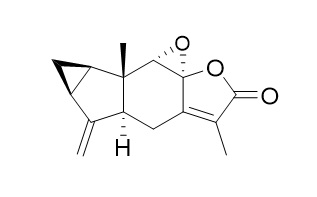Chloranthalactone B
Chloranthalactone B has anti-inflammatory activity, it inhibits the production of inflammatory mediators by inhibiting the AP-1 and p38 MAPK pathways.
Inquire / Order:
manager@chemfaces.com
Technical Inquiries:
service@chemfaces.com
Tel:
+86-27-84237783
Fax:
+86-27-84254680
Address:
1 Building, No. 83, CheCheng Rd., Wuhan Economic and Technological Development Zone, Wuhan, Hubei 430056, PRC
Providing storage is as stated on the product vial and the vial is kept tightly sealed, the product can be stored for up to
24 months(2-8C).
Wherever possible, you should prepare and use solutions on the same day. However, if you need to make up stock solutions in advance, we recommend that you store the solution as aliquots in tightly sealed vials at -20C. Generally, these will be useable for up to two weeks. Before use, and prior to opening the vial we recommend that you allow your product to equilibrate to room temperature for at least 1 hour.
Need more advice on solubility, usage and handling? Please email to: service@chemfaces.com
The packaging of the product may have turned upside down during transportation, resulting in the natural compounds adhering to the neck or cap of the vial. take the vial out of its packaging and gently shake to let the compounds fall to the bottom of the vial. for liquid products, centrifuge at 200-500 RPM to gather the liquid at the bottom of the vial. try to avoid loss or contamination during handling.
Eur J Pharmacol.2021, 899:174010.
Front. Pharmacol.2022, 901563.
Nutrients.2021, 13(1):254.
Nutrients.2023, 15(13):2960.
J Chromatogr B Analyt Technol Biomed Life Sci. 2017, 1064:115-123
Plant Cell, Tissue and Organ Culture (PCTOC)2020, 143, 45-60(2020)
Molecules2022, 27(12):3903.
Chin J Appl. Physiol.2019, 35(3):283-288
Curr Med Sci.2024, 44(2):355-368.
J Appl Biol Chem.2021, 64(3),263?268
Related and Featured Products
Int J Mol Sci. 2016 Nov 22;17(11). pii: E1938.
Anti-Inflammatory Effects of Chloranthalactone B in LPS-Stimulated RAW264.7 Cells.[Pubmed:
27879664 ]
Chloranthalactone B (CTB), a lindenane-type sesquiterpenoid, was obtained from the Chinese medicinal herb Sarcandra glabra, which is frequently used as a remedy for inflammatory diseases. However, the anti-inflammatory mechanisms of CTB have not been fully elucidated.
METHODS AND RESULTS:
In this study, we investigated the molecular mechanisms underlying these effects in lipopolysaccharide (LPS)-stimulated RAW264.7 macrophages. CTB strongly inhibited the production of nitric oxide and pro-inflammatory mediators such as prostaglandin E₂, tumor necrosis factor α (TNF-α), interleukin-1β (IL-1β), and IL-6 in RAW264.7 cells stimulated with LPS. A reverse-transcription polymerase chain reaction assay and Western blot further confirmed that CTB inhibited the expression of inducible nitric oxide synthase, cyclooxygenase-2, TNF-α, and IL-1β at the transcriptional level, and decreased the luciferase activities of activator protein (AP)-1 reporter promoters. These data suggest that inhibition occurred at the transcriptional level. In addition, CTB blocked the activation of p38 mitogen-activated protein kinase (MAPK) but not c-Jun N-terminal kinase or extracellular signal-regulated kinase 1/2. Furthermore, CTB suppressed the phosphorylation of MKK3/6 by targeting the binding sites via formation of hydrogen bonds.
CONCLUSIONS:
Our findings clearly show that CTB inhibits the production of inflammatory mediators by inhibiting the AP-1 and p38 MAPK pathways. Therefore, CTB could potentially be used as an anti-inflammatory agent.
Chem Pharm Bull (Tokyo). 2009 Apr;57(4):418-20.
Three novel sesquiterpene glycosides of Sarcandra glabra.[Pubmed:
19336941]
METHODS AND RESULTS:
Three new sesquiterpene glycosides, 8 beta,9 beta-epoxy-4 alpha-hydroxy-5 alpha H-lindan-7(11)-en-8 alpha,12-olide-15-O-beta-D-glucopyranoside (1, sarcaglaboside F), 4 alpha-hydroxy-5 alpha,8 beta H-lindan-7(11)-en-8 alpha,12-olide-15-O-beta-D-glucopyranoside (2, sarcaglaboside G), 4 alpha-hydroxy-5 alpha,8 beta H-eudesman-7(11)-en-8 alpha,12-olide-15-O-beta-D-glucopyranoside (3, sarcaglaboside H), together with five known compounds, chloranoside A (4), sarcaglaboside C (5), dihydrovomifoliol-O-beta-D-glucopyranoside (6), 9-hydroxy-heterogorgiolide (7) and Chloranthalactone B (8), were isolated from Sarcandra glabra THUMB. NAKAI. The structures and relative configurations of three new compounds were determined on the basis of their spectroscopic data and chemical evidence.



